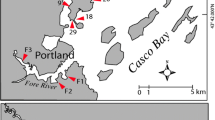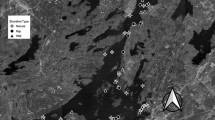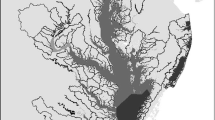Abstract
Terraced salt marsh restoration projects have been designed to maximize edge because the edges between habitat types have been shown to be the most productive locations in Spartina alterniflora salt marshes for nekton and benthic infauna. We compared terraced plots with reference plots to see how much edge was created. We also quantified the differences in the spatial patterns of the habitat in the plots. We found that reference marshes had significantly more habitat diversity and more total low marsh area. We also found that reference marshes had a greater absolute amount of low marsh edge. Yet, we found little difference between terraced restoration marshes and nearby reference marshes in Galveston Bay, Texas, USA in terms of the percent of all habitat-to-habitat edge-type combinations that were aquatic edge (water- or seagrass-to-low marsh interface), and much of the reference marshes’ area was in core marsh areas that were not suitable for high fisheries production value. Terracing appears an efficient strategy for the sole purpose of creating aquatic edge for fisheries production but does not appear to match other aspects of reference marshes in terms of their habitat composition or spatial configuration. This study shows the potential for using spatial pattern analysis to monitor restoration projects in the future.
Similar content being viewed by others
Literature Cited
Bell, S. S., M. S. Fonseca, and L. B. Motten. 1997. Linking restoration and landscape ecology. Restoration Ecology 5: 318–323.
Blackburn, J. B. 2004. The Book of Texas Bays. Texas A & M University Press, College Station, TX, USA.
Brandt, L. A., K. M. Portier, and W. M. Kitchens. 2000. Patterns of change in tree islands in Arthur R. Marshall Loxahatchee National Wildlife Refuge from 1950 to 1991. Wetlands 20: 1–14.
Brinson, M. M. and R. Rheinhardt. 1996. The role of reference wetlands in functional assessment and mitigation. Ecological Applications 6: 69–76.
Broome, S. W., E. D. Seneca, and W. W. Woodhouse, Jr. 1988. Tidal salt marsh restoration. Aquatic Botany 32: 1–22.
Costanza, R., R. d’Arge, R. de Groot, S. Farber, M. Grasso, B. Hannon, K. Limburg, S. Naeem, R. V. O’Neill, J. Paruelo, R. G. Raskin, P. Sutton, and M. van den Belt. 1997. The value of the world’s ecosystem services and natural capital. Nature 387: 253–260.
Delaney, T. P., J. W. Webb, and T. J. Minello. 2000. Comparison of physical characteristics between created and natural estuarine marshes in Galveston Bay, Texas. Wetlands Ecology and Management 8: 343–352.
De Steven, D. and M. M. Toner. 2004. Vegetation of Upper Coastal Plain depressional wetlands: Environmental templates and wetland dynamics within a landscape framework. Wetlands 24: 23–42.
Edwards, K. R. and C. E. Proffitt. 2003. Comparison of wetland structural characteristics between created and natural salt marshes in southwest Louisiana, USA. Wetlands 23: 344–356.
Feagin, R. A. 2005. Artificial dunes created to protect private property on Galveston Island, Texas: the lessons learned. Ecological Restoration 23: 89–94.
Haas, H. L., K. A. Rose, B. Fry, T. J. Minello, and L. P. Rozas. 2004. Brown shrimp on the edge: Linking habitat to survival using an individual-based simulation model. Ecological Applications 14: 1232–1247.
Havens, K. J., L. M. Varnell, and J. G. Bradshaw. 1995. An assessment of ecological conditions in a constructed tidal marsh and two natural reference tidal marshes in coastal Virginia. Ecological Engineering 4: 117–141.
Havens, K. J., L. M. Varnell, and B. D. Watts. 2002. Maturation of a constructed tidal marsh relative to two natural reference tidal over 12 years. Ecological Engineering 18: 305–315.
Hirano, A., M. Madden, and R. Welch. 2003. Hyperspectral image data for mapping wetland vegetation. Wetlands 23: 436–448.
Hughes, R. G. 2004. Climate change and the loss of saltmarshes: Consequences for birds. Ibis 146: 21–28.
Intergovernmental Panel on Climate Change. 2001. Climate change 2001: impacts, adaptation, and vulnerability. J. J. McCarthy, O. F. Canziani, N. A. Leary, D. J. Dokken, and K. S. White (eds.) Contribution of Working Group II to the Third Assessment Report of the Intergovernmental Panel on Climate Change. Cambridge University Press, New York, NY, USA.
Jensen, J. R. 1996. Introductory Digital Image Processing: A Remote Sensing Perspective, second edition. Prentice-Hall, Inc., Upper Saddle River, NJ, USA.
Lentner, M. and T. Bishop. 1993. Experimental Design and Analysis. 2nd Edition. Valley Book Company, Blacksburg, VA, USA.
Leonard, L. A., P. A. Wren, and R. L. Beavers. 2002. Flow dynamics and sedimentation in Spartina alterniflora and Phragmites australis marshes of the Chesapeake Bay. Wetlands 22: 415–424.
McGarigal, K., S. A. Cushman, M. C. Neel, and E. Ene. 2002. FRAGSTATS: Spatial Pattern Analysis Program for Categorical Maps. University of Massachusetts, Amherst, Massachussetts, USA. Available at the following web site: www.umass. edu/landeco/research/fragstats/fragstats.html
McGarigal, K. and B. J. Marks. 1995. FRAGSTATS: Spatial pattern analysis program for quantifying landscape structure. USDA Forest Service, Pacific Northwest Research Station, Portland, OR, USA. General Technical Report, PNW-GTR-351.
Minello, T. J. and R. J. Zimmerman. 1992. Utilization of natural and transplanted Texas salt marshes by fish and decapod crustaceans. Marine Ecology Progress Series 90: 273–285.
Minello, T. J., R. J. Zimmerman, and R. Medina. 1994. The importance of edge for natant macrofauna in a created salt marsh. Wetlands 14: 184–198.
Minello, T. J. and L. P. Rozas. 2002. Nekton in Gulf Coast wetlands: Fine-scale distributions, landscape patterns, and restoration implications. Ecological Applications 12: 441–455.
Mitsch, W. J. and X. Wu. 1995. Wetlands and global change. p. 205–230. In R. Lal, J. Kimble, E. Levine, and B. A. Stewart (eds.) Advances in Soil Science: Soil Management and Greenhouse Effect. CRC Press/Lewis Publishers, Boca Raton, FL, USA.
Mitsch, W. J. and J. G. Gosselink. 2000. Wetlands, third edition. John Wiley and Sons, Inc., New York, NY, USA.
Mitsch, W. J., X. Wu, R. W. Nairn, P. E. Weihe, N. Wand, R. Deal, and C. E. Boucher. 1998. Creating and restoring wetlands: A whole-ecosystem experiment in self-design. Bio-Science 48: 1019–1030.
Moorhead, K. K. and M. M. Brinson. 1995. Response of wetlands to rising sea level in the lower coastal plain of North Carolina. Ecological Applications 5: 261–271.
Moy, L. D. and L. A. Levin. 1991. Are Spartina marshes a replaceable resource? A functional approach to evaluation of marsh creation effort. Estuaries 14: 1–16.
Paine, R. T. and S. A. Levin. 1998. Intertidal landscapes: disturbance and the dynamics of pattern. Ecological Monographs 51: 145–178.
Palmer, M. L. and F. J. Mazzotti. 2004. Structure of Everglades alligator holes. Wetlands 24: 115–122.
Peterson, G. W. and R. E. Turner. 1994. The value of salt marsh edge vs interior as a habitat for fish and decapod crustaceans in a Louisiana tidal marsh. Estuaries 17: 235–262.
Phinn, S. R., D. A. Stow, and J. B. Zedler. 1996. Monitoring wetland habitat restoration in southern California using airborne multispectral video data. Restoration Ecology 4: 412–422.
Rozas, L. P. and T. J. Minello. 2001. Marsh terracing as a wetland restoration tool for creating fishery habitat. Wetlands 21: 327–341.
Rozas, L. P., P. Caldwell, and T. J. Minello. 2005. The fishery value of salt marsh restoration projects. Journal of Coastal Research 40: 37–50.
Sacco, J. N., E. D. Seneca, and T. R. Wentworth. 1994. Infaunal community development of artificially established salt marshes in North Carolina. Estuaries 17: 489–500.
SAS Institute Inc. 1985. SAS User’s Guide: Statistics. 5th Edition. SAS Institute, Cary, NC, USA.
Shi, Z., J. S. Pethick, and K. Pye. 1995. Flow structure in and above the various heights of a saltmarsh canopy: a laboratory flume study. Journal of Coastal Research 11: 1204–1209.
Tiner, R. W. 1993. Field Guide to Coastal Wetland Plants of the Southeastern United States. University of Massachussetts Press, Amherst, MA, USA.
Webb, J. W. and C. J. Newling. 1985. Comparison of natural and man-made salt marshes in Galveston Bay complex, Texas. Wetlands 4: 75–86.
Whaley, S. D. and T. J. Minello. 2002. The distribution of benthic infauna of a Texas salt marsh in relation to the marsh edge. Wetlands 22: 753–766.
Wu, X. and W. J. Mitsch. 1998. Spatial and temporal patterns of algae in newly constructed freshwater wetlands. Wetlands 18: 9–20.
Wu, X. B., T. L. Thurow, and S. G. Whisenant. 2000. Fragmentation and changes in hydrologic function of tiger bush landscapes, southwest Niger. Journal of Ecology 88: 790–800.
Zedler, J. B., J. C. Callaway, J. Desmond, G. Vivian-Smith, G. D. Williams, G. Sullivan, A. Brewster, and B. Bradshaw. 1999. Californian saltmarsh vegetation: An improved model of spatial pattern. Ecosystems 2: 19–35.
Zedler, J. B. and R. Langis. 1991. Comparisons of constructed and natural salt marshes of San Diego Bay. Restoration and Management Notes 9: 21–25.
Author information
Authors and Affiliations
Corresponding author
Rights and permissions
About this article
Cite this article
Feagin, R.A., Wu, X.B. Spatial pattern and edge characteristics in restored terrace versus reference salt marshes in Galveston Bay. Wetlands 26, 1004–1011 (2006). https://doi.org/10.1672/0277-5212(2006)26[1004:SPAECI]2.0.CO;2
Received:
Revised:
Accepted:
Issue Date:
DOI: https://doi.org/10.1672/0277-5212(2006)26[1004:SPAECI]2.0.CO;2




